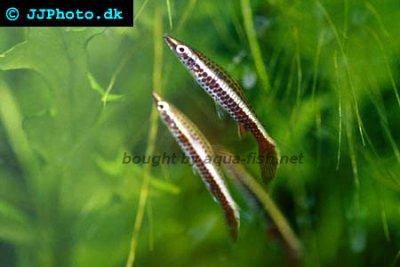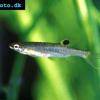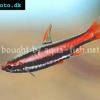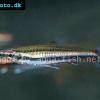Brown pencilfish - Nannostomus eques
Scientific name: Nannostomus eques
Common name: Brown pencilfish
Family: Lebiasinidae
Usual size in fish tanks: 4 - 6 cm (1.57 - 2.36 inch)
014
Recommended pH range: 6 - 7.8
Recommended water hardness: 4 - 14°N (71.43 - 250ppm)
0°C 32°F30°C 86°F
Recommended temperature range: 23 - 29 °C (73.4 - 84.2°F)
The way how these fish reproduce: Spawning
Where the species comes from: South America
Temperament to its own species: peaceful
Temperament toward other fish species: peaceful
Usual place in the tank: Top levels
Origin
Brown Pencilfish (Nannostomus eques) originate from the freshwater rivers and streams of South America, particularly in the Amazonian Basins of Guyana and Colombia. They are commonly found in slow-moving waters, including floodplains and small creeks densely packed with aquatic vegetation. These environments provide ample hiding spots and are rich in leaf litter, which helps create blackwater conditions. In their natural habitat, they are often seen hovering near the water surface at an angle, a behavior that makes them stand out among other fish species. Mimicking these conditions in the home aquarium is essential for their well-being.
Tank Setup and Environment
To keep Brown Pencilfish comfortable, a tank of at least 60 liters (15 gallons) is recommended for a small group. These fish thrive in heavily planted aquariums with a dark substrate, which enhances their coloration and provides them with a sense of security. Floating plants, such as Water Sprite, help to diffuse the lighting, creating the dim conditions they prefer. Adding driftwood and leaf litter not only creates hiding places but also simulates their natural blackwater habitat by releasing tannins into the water.
Maintain a gentle water flow, as these fish are accustomed to slow-moving waters. Use a gentle filter to avoid creating strong currents, which can stress them. The ideal water conditions include a pH range of 6.0 to 7.8, a hardness of 4-14°N, and a temperature between 23-29°C (73.4-84.2°F). Regular water changes are crucial to maintaining water quality and ensuring a stress-free environment for these delicate fish.
Food and Feeding
Brown Pencilfish are omnivores and have small mouths, so they require appropriately sized food. They readily accept high-quality flake food but should also be offered a variety of live and frozen foods such as bloodworms, brine shrimp, and daphnia. These protein-rich treats help bring out their natural colors and promote overall health. Additionally, they will constantly graze on algae present in the tank, which supplements their diet.
Due to their small size and tiny stomachs, it is advisable to feed them small meals twice daily rather than one large meal. This feeding routine helps prevent overfeeding and keeps the water quality in check. Ensure that the food is finely crushed or small enough to fit into their mouths to avoid choking and promote proper digestion.
Sexing
Sexing Brown Pencilfish can be achieved by observing their size and coloration. Males are generally slimmer and exhibit more vibrant colors compared to females. During the breeding season, males may display intensified colors to attract females. Females are usually fuller-bodied, especially when they are carrying eggs, making them easier to identify during this period.
Breeding
Breeding Brown Pencilfish can be challenging, but it is possible with the right conditions. Begin by conditioning the breeding pair with a protein-rich diet of live or frozen foods, such as bloodworms and brine shrimp, for about two weeks. Set up a separate breeding tank with a soft, slightly acidic water (pH around 6.5) and a temperature elevated to around 29°C (84.2°F). The tank should be heavily planted with fine-leaved plants or spawning mops to provide suitable surfaces for egg deposition.
These fish typically lay their eggs on the underside of leaves, preferring broad-leaved plants such as Anubias. After spawning, promptly remove the parents, as they may eat the eggs. The eggs will hatch in 2-3 days, and once the fry are free-swimming, they can be fed infusoria or micro-worms. It is crucial to maintain a clean environment and use an air-driven sponge filter to avoid sucking the fry into the filtration system. Frequent water changes are necessary to ensure the healthy development of the fry.
Lifespan
Brown Pencilfish have a lifespan of 3-5 years in captivity. With proper care, including a varied diet, stable water conditions, and a stress-free environment, they can live to their maximum potential. Regular monitoring of water parameters and a peaceful tank environment will contribute to their longevity and overall well-being.
Short Description
Brown Pencilfish (Nannostomus eques) are peaceful and timid fish known for their unique swimming behavior, often hovering near the water surface at an angle. They thrive in heavily planted aquariums with dim lighting and minimal water flow, mimicking their natural habitat in the Amazon Basin. Best kept in small groups, they are an excellent addition to community tanks with other non-aggressive species. Their delicate nature requires careful attention to water quality and a varied diet. Their distinctive behavior and striking appearance make them a favorite among aquarists looking to add a touch of the Amazon to their tanks.
Pictures
Bought by aqua-fish.net from jjphoto.dk.







 Splashing
Splashing  Dwarf
Dwarf  Coral-red
Coral-red  Threestripe
Threestripe